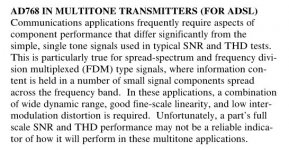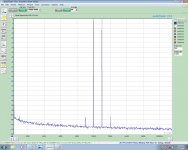Since I'm not that interested in chasing measurable parameters I'd have to make a guess. PSRR?
In reply to your recent addition - 'suspicious' I'm not. But I'd be surprised if optimizing the THD+N had the result of making it sound more transparent because this runs counter to my own experience with circuitry.
Why would the THD+N of the DAC matter when the amp and speaker (taken as a single unit) are going to be considerably (orders of magnitude) worse in that same metric?
In reply to your recent addition - 'suspicious' I'm not. But I'd be surprised if optimizing the THD+N had the result of making it sound more transparent because this runs counter to my own experience with circuitry.
Why would the THD+N of the DAC matter when the amp and speaker (taken as a single unit) are going to be considerably (orders of magnitude) worse in that same metric?
Last edited:
A counter question: Show us the scientific blind studies that show what measureable parameters are important? (or even audible).
dave
dave
Well since you're not interested in measurable parameters, you guys can continue to design and select the best DAC in the world by dartboard.
Now who's 'dancing around questions' - in fact you totally ignored it.
Here it is again - Why would the THD+N of the DAC matter when the amp and speaker (taken as a single unit) are going to be considerably (orders of magnitude) worse in that same metric?
Here it is again - Why would the THD+N of the DAC matter when the amp and speaker (taken as a single unit) are going to be considerably (orders of magnitude) worse in that same metric?
I'm not designing DACs, i'm listening to them.
Good measures, and the ability to interpret them, is essential to tracking down your mistakes & check your progress (note: THD isn't one of them -- althou HD is), but you have to have some design skills & savy, and you have to listen to it.
dave
Good measures, and the ability to interpret them, is essential to tracking down your mistakes & check your progress (note: THD isn't one of them -- althou HD is), but you have to have some design skills & savy, and you have to listen to it.
dave
Now who's 'dancing around questions' - in fact you totally ignored it.
Here it is again - Why would the THD+N of the DAC matter when the amp and speaker (taken as a single unit) are going to be considerably (orders of magnitude) worse in that same metric?
I never said it did, but I'm not the one criticizing designs. There is no point in continuing discussion because you can't argue against pixie dust.
I don't think THD matters itself per-se below a resonable level, but THD at high frequencies and with demanding loads might be viewed as an easy to measure proxy for other more esoteric types of non-linearities. I am wondering if there are non-linearities that are not reduced by the same mechanisms as chasing low THD?
Other than that, why wouldn't you reduce it? I am not sure what you are sacrificing? No one else likes overkill?
Other than that, why wouldn't you reduce it? I am not sure what you are sacrificing? No one else likes overkill?
The designers of DACs intended for communications purposes (where high crest factor signals, not entirely unlike music are handled) seemed to think there was the need for something other than THD+N. So they created MTPF as a new form of IMD measurement - this from an old ADI DAC datasheet -
Let's turn your question around - when is a THD+N measurement 'good enough' ? Why continue to reduce it when there's no apparent need, unless its all about marketing?
Let's turn your question around - when is a THD+N measurement 'good enough' ? Why continue to reduce it when there's no apparent need, unless its all about marketing?
Attachments
Last edited:
I don't think THD matters
THD is a number collapsed from the HD which measures the size of all the components, 2nd, 3rd, 4th etc. You lose all the information about each, and their relationship with each other. 2nd order for instance can be quite with nosonic issues, 3rd should be lower and if they exist higher should decrease monotonically. Very small amounts of higher order harmonics can be very objectionable. At least that is a pretty broadly held belief… i have yet to see an actual blind study that validates that belief.
dave
Here it is again - Why would the THD+N of the DAC matter when the amp and speaker (taken as a single unit) are going to be considerably (orders of magnitude) worse in that same metric?
Because final distortion is a multiplication function of distortion in every stages (not determined by the bottleneck).
You seem to be saying it was high amounts of NFB. Probably. But there is a BIG difference between a mediocre amplifier with lots of NFB used to get a low 1kHz THD number for a spec sheet, and a well designed amplifier with good open-loop performance and then NFB wrapped around it.
Current mirror. It's an instant way to minimize distortion.
Lower THD is favorable, but the comparison must be "apple to apple". Cannot compare one with current mirror with one without. Same with DAC. Delta Sigma PCM4490 with NE5532 cannot be compared with NOS DAC-END with tube output.
Maybe some people making extraordinary claims might want to list what gets worse while making THD+N better.
DAC linearity. Increasing THD+N (from 20Hz-20kHz) can be done with maximizing sampling rate. The 24k residual noise might create audible issue to the tweeter or wide band amplifier. When the frequency is very high, high speed opamp is a must, giving another issue with opamp inherent limitation. (With lower frequency we can use tube).
Because final distortion is a multiplication function of distortion in every stages (not determined by the bottleneck).
Put some flesh on the bones of this. Let's suppose both the DAC and the amp have 0.001% distortion and the speakers have 0.2%. What's the final distortion at the output of the speakers?
Put some flesh on the bones of this. Let's suppose both the DAC and the amp have 0.001% distortion and the speakers have 0.2%. What's the final distortion at the output of the speakers?
Nice One.
Should be a piece of cake if you have 20 years of software experience.
The PC/PCI card combo I use has an insanely low noise level. I keep hearing about the awfulness of the PC environment, but I can't seem to hear or measure it.
SY I need your advice then, below is a file that demonstrates the noise from my PC by just moving the mouse, I used my mobile phone as recorder.
The PC noise is not insanely low! My home PC is an HP and work is a Dell, same noise both PCs. My home PC has "the best" From Asus, my work PC has "Creative Labs X-Fi". When there is high disc activity it is a lot worse.
Sorry for the knocks, it is from the phone knocking against the speakers.
Attachments
Hence my original questions. Does an external DAC solve all these problems? I am assuming the bits are near perfect in my PC since software runs pretty okay.
Put some flesh on the bones of this. Let's suppose both the DAC and the amp have 0.001% distortion and the speakers have 0.2%. What's the final distortion at the output of the speakers?
Anywhere between 0.199 and 0.201%.
SY I need your advice then, below is a file that demonstrates the noise from my PC by just moving the mouse, I used my mobile phone as recorder.
I don't typically mouse around when I'm seriously listening to music or recording. 😀
Here's the noise floor I get (IMD test with phono stage at the input, which dominates the noise). Without the phono front end, the noise floor is even lower, but I don't have those plots on this computer; they are shown in my AX articles. Cheap HP desktop, M-Audio 192 card.
Attachments
Anywhere between 0.199 and 0.201%.
I can't escape that conclusion either - how can the speakers then not be the bottleneck for THD+N?
- Home
- Member Areas
- The Lounge
- World's Best DAC's

